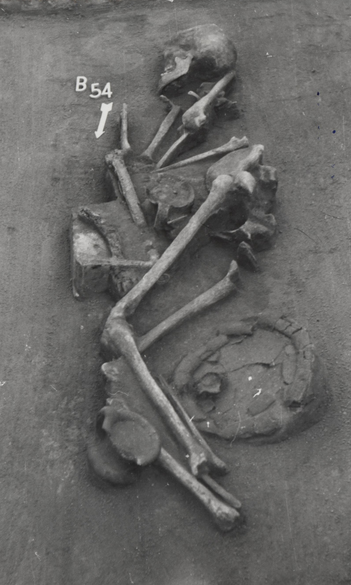A turning point in the Bronze Age: the diet was changed and the society was transformed

The multidisciplinary research was based on the Bronze Age cemetery excavated at Tiszafüred-Majoroshalom, which was used both in the Middle Bronze Age (Füzesabony culture) and in the Late Bronze Age (Tumulus culture). These finds allowed the researchers to compare the subsistence strategies before and after the change of era.
The research team, led by Tamás Hajdu and supported by the Hungarian National Research, Development and Innovation Office, sought to answer whether the spread of the Tumulus culture meant the arrival of new groups, or whether the autochtonous people continued their lives, and only the material culture changed. In addition, they also examined whether the archaeologically observed settlement changes around 1500 BC indicate a change in lifestyle: whether people began to follow a lifestyle involving mainly animal husbandry and frequent migration instead of settled farming.
The most important results of the research:
Diet changed: According to nitrogen stable isotope studies, people's food consumption was much more diverse during the Middle Bronze Age, and differences within society were also more evident in their diet - especially in access to animal proteins. This difference decreased in the Late Bronze Age, and the diet became more uniform but poorer.
Broomcorn millet was introduced: According to carbon isotope analyses, the consumption of millet, a plant that can be grown quickly and has a high energy content, began at the beginning of the Late Bronze Age. The data from the Tiszafüred Bronze Age cemetery indicate the earliest known consumption of millet in Europe.
Mobility decreased: According to the results of strontium isotope investigations, the populations of the Middle and Late Bronze Age Tiszafüred had different mobility patterns. In the Late Bronze Age, fewer immigrants were identified and they arrived from different migration source than before. While in the Middle Bronze Age, beside the locals, several immigrants were observed among the people living in Tiszafüred, and they most likely did not come from too far away (e.g. the Upper Tisza region, the northern part of the Carpathians), while in the Late Bronze Age, the settlers may have come from other geographical regions (e.g. Transdanubia or the Southern Carpathians). Based on radiocarbon dating, immigration began as early as the 1500s BC, which supports that the communities living further west had indeed reached the Great Hungarian Plain at the time of the appearance of the Tumulus culture.
Social relations changed: At the beginning of the Late Bronze Age, the long time-used tell-settlements were abandoned and people lived in less centralized settlement networks. This change created a looser, less structured social system – which is also reflected in dietary habits. According to microremains found in dental calculi and the aforementioned isotopic analyses, significantly less animal protein was consumed during this period than before, which contradicts the previous idea that people belonging to the Tumulus culture were mainly engaged in animal husbandry.
The study, published in the journal Scientific Reports, clearly refutes the previous idea that Tumulus culture people were mostly pastoralists. The research results show that the changes associated with the emergence of the Tumulus culture (around 1500 BC) – such as the observed differences in people's lifestyles, burial customs and settlements – can only be truly understood if traditional archaeological and anthropological studies are combined with modern bioarchaeological analyses.
Illustrations
Tiszafüred-Majoroshalom temetőjében a 87Sr/86Sr és 14C adatok megoszlása a biológiai nemmel és az időrendi fázisokkal összefüggésében
A fogkő vizsgálatok eredményei Tiszafüred-Majoroshalom lelőhelyről;
kék oszlop: a mintázott egyének számát jelzi,
zöld oszlop: mikromaradványokat tartalmazó fogkővel rendelkező egyének száma,
szürke oszlop: növényi mikromaradványok tartalmazó fogkővel rendelkező egyének száma,
narancs oszlop: köles mikromaradványokat tartalmazó fogkővel rendelkező egyének száma
Cover: Tiszafüred Majoroshalom B54. sír (MNMKK MNM AD HaGy Kovács Tibor hagyatéka). A hivatkozás hozzá: Kovács 1995, Abb. 1/A, 2-3 és Dani János et al. 2025
Kovács, T (1995) Auf Mitteleuropa weisende Beziehungen einiger Waffenfunde aus dem östlichen Karpatenbecken. In Hänsel, B (Hrsg.), Handel, Tausch und Verker im bronze- und früheisenzeitlichen Südosteuropa. Prähistorische Archäologie in Südosteuropa 11. Südosteuropa-Gesellschaft, München-Berlin, 173–185. és Dani J, Horváth A, Gémes A, Fülöp K, Szeniczey T, Tarbay JG, et al. New radiocarbon dates from the Bronze Age Tiszafüred-Majoroshalom site (Eastern Hungary). Radiocarbon. 2025;67(2):428–40. doi:10.1017/RDC.2024.123
Collaborators
The following researchers participated in the preparation of the study:
- Claudio Cavazzuti (Department of History and Culture, Alma Mater Studiorum, University of Bologna)
- Anett Gémes and Tamás Szeniczey (Department of Biological Anthropology, Institute of Biology, Faculty of Science, Eötvös Loránd University)
- Tamás Hajdu and Mario Novak (Department of Biological Anthropology, Institute of Biology, Faculty of Science, Eötvös Loránd University and Institute for Anthropological Research, Zagreb)
- Gábor János Tarbay and Magdolna Vicze (National Institute of Archaeology, Hungarian National Museum, Hungarian National Museum Public Collection Centre)
- Ashley McCall and Beatriz Gamarra (independent researchers)
- Annamária Bárány (ELTE Museum of Natural History)
- Ákos Pető (Department of Nature Conservation and Landscape Management, Institute for Wildlife Management and Nature Conservation, Hungarian University of Agriculture and Life Sciences)
- Katalin Enikő Magyari and Gabriella Darabos (Department of Environmental and Landscape Geography, Institute of Geography and Earth Sciences, Center of Geography, Faculty of Science, Eötvös Loránd University)
- Anikó Horváth, István Futó, Mihály Molnár, István Major and László Palcsu (HUN-REN Institute for Nuclear Research)
- Zsuzsa Lisztes-Szabó (HUN-REN Institute for Nuclear Research and Botanical Department, Faculty of Science and Technology, University of Debrecen)
- Erika Molnár (Department of Biological Anthropology, University of Szeged)
- Viktória Kiss, Erika Gál, Klára P. Fischl, Gabriella Kulcsár and Kristóf Fülöp (Institute of Archaeology, HUN-REN Research Centre for the Humanities)
- Géza Szabó (Wosinsky Mór Museum)
- Vajk Szeverényi (Department of Archaeology, University of Miskolc)
- Edit Mester (Kiss Pál Museum)
- János Dani (Department of Archaeology, Faculty of Humanities at Szeged University and Déri Museum)

